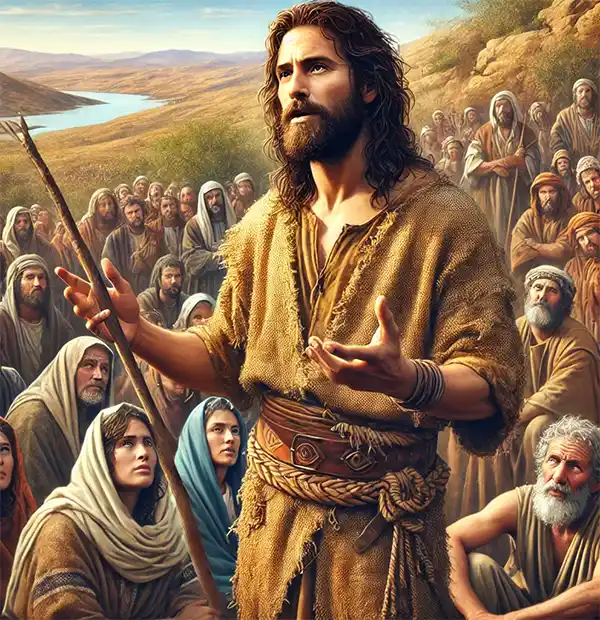A Celebration of the Beloved Apostle
St. John’s Day, celebrated on June 24th, honors St. John the Baptist, one of the most significant figures in Christianity. This day, steeped in history, tradition, and spirituality, provides an opportunity to reflect on the life and legacy of the saint known for his profound role in the New Testament.
The Life of St. John the Baptist
St. John the Baptist, born to Zechariah and Elizabeth, was a prophet who played a pivotal role in preparing the way for Jesus Christ. According to the Gospel of Luke, John’s birth was miraculous, as his parents were advanced in age and childless. An angel appeared to Zechariah, announcing that they would have a son who would be filled with the Holy Spirit even before birth. Elizabeth, a relative of Mary, mother of Jesus, experienced a miraculous pregnancy that would herald the coming of the Messiah.
John's life was marked by asceticism and unwavering devotion. He lived in the wilderness, clothed in camel’s hair and sustained by locusts and wild honey. His mission was clear: to preach repentance and baptize those who sought forgiveness. John’s baptism was not merely a ritual but a powerful symbol of spiritual cleansing and renewal.
 He was widely recognized as a powerful preacher, attracting crowds who sought his guidance and baptism. Many believed him to be a prophet in the tradition of Elijah, a connection reinforced by his austere lifestyle and fearless condemnation of corruption. His influence reached even the religious elite, prompting both admiration and opposition. His followers, including some who would later become disciples of Jesus, saw him as a figure of profound spiritual authority, emphasizing the importance of righteousness and humility.
He was widely recognized as a powerful preacher, attracting crowds who sought his guidance and baptism. Many believed him to be a prophet in the tradition of Elijah, a connection reinforced by his austere lifestyle and fearless condemnation of corruption. His influence reached even the religious elite, prompting both admiration and opposition. His followers, including some who would later become disciples of Jesus, saw him as a figure of profound spiritual authority, emphasizing the importance of righteousness and humility.
The Baptism of Jesus
One of the most significant events in John’s life was the baptism of Jesus in the River Jordan. This event, described in all four Gospels, marks the beginning of Jesus’ public ministry. John initially hesitated, feeling unworthy to baptize the one he called the Lamb of God, who takes away the sin of the world. However, Jesus insisted, and upon being baptized, the heavens opened, and the Spirit of God descended like a dove, with a voice from heaven proclaiming, “This is my beloved Son, in whom I am well pleased.”
John’s fearless preaching and denunciation of sin eventually led to his martyrdom. He openly criticized King Herod Antipas for marrying Herodias, his brother’s wife, a union considered unlawful. Herodias harbored a grudge against John and sought his death. Her opportunity came during Herod’s birthday banquet when her daughter Salome performed a dance that pleased Herod so much he promised her anything she desired. Prompted by her mother, Salome requested John’s head on a platter. Though distressed, Herod fulfilled the request to save face before his guests, leading to John’s execution.
Traditions and Celebrations of St. John’s Day
St. John’s Day, also known as the Feast of St. John the Baptist, is celebrated with various traditions and customs worldwide. It coincides with Midsummer celebrations in many cultures, blending Christian and pagan customs in a unique fusion of faith and festivity.
- Bonfires and Festivities: One of the most prominent traditions is the lighting of bonfires. This practice symbolizes the light that St. John brought into the world and the light of Christ that he foretold. In countries like Spain, France, and Portugal, people gather around large bonfires, singing, dancing, and sometimes jumping over the flames as a symbol of purification and good fortune.
- Water Blessings: Given John’s association with baptism, water plays a significant role in St. John’s Day celebrations. In parts of Europe, people take early morning dips in rivers, lakes, or the sea, believing the waters hold special blessings and healing properties on this day. In some regions, priests bless the waters, and people collect this holy water for use throughout the year.
- Processions and Masses: In many Catholic communities, St. John’s Day is marked by processions and special Masses. Statues of St. John the Baptist are paraded through the streets, accompanied by prayers, hymns, and the faithful. These processions are acts of devotion, reflecting the community’s reverence for the saint and his example of steadfast faith.
St. John in Art and Literature
St. John the Baptist has inspired countless works of art and literature throughout the centuries. From Leonardo da Vinci’s iconic paintings to Donatello's evocative sculptures, artists have sought to capture John’s spiritual intensity and pivotal role in Christian history. He is often depicted as a wild yet holy figure, clothed in rough garments, holding a staff or a lamb, symbolizing his connection to Christ. Renaissance artists like Caravaggio and Raphael painted vivid scenes of John's baptism of Jesus, emphasizing the dramatic spiritual significance of the event.
In literature, John’s life and teachings have been explored in numerous texts, emphasizing his importance as a precursor to Christ and a model of prophetic zeal. Medieval religious texts often presented him as a bridge between the Old and New Testaments, reinforcing his role as the last great prophet before the arrival of the Messiah. His story also appears in modern poetry and literature, reflecting themes of sacrifice, righteousness, and divine mission. Even in contemporary fiction, John’s character remains a powerful symbol of faith and conviction, reinforcing his lasting impact on both religious thought and artistic interpretation.
St. John the Baptist’s legacy endures as a beacon of faith, courage, and devotion through the ages. His message of repentance and spiritual renewal continues to resonate with believers worldwide. His unwavering commitment to truth and righteousness has made him a model of prophetic integrity and fearless preaching.
 The Enduring Legacy of St. John
The Enduring Legacy of St. John
Beyond religious devotion, St. John’s legacy is embedded in cultural traditions, historical narratives, and the collective consciousness of societies that honor his life and mission. His feast day remains one of the most widely observed Christian celebrations, merging faith with cultural heritage in profound and lasting ways.
St. John’s example encourages reflection on personal faith, the call to righteousness, and the importance of humility in spiritual life. His story reminds us that faith often requires strength and perseverance, inspiring countless individuals to live with integrity and purpose.
May the light of St. John’s Day inspire us to seek renewal and embrace the path of righteousness, following in the footsteps of the beloved apostle who heralded the dawn of a new era in the Christian faith.
Please Share our Content






 He was widely recognized as a powerful preacher, attracting crowds who sought his guidance and baptism. Many believed him to be a prophet in the tradition of Elijah, a connection reinforced by his austere lifestyle and fearless condemnation of corruption. His influence reached even the religious elite, prompting both admiration and opposition. His followers, including some who would later become disciples of Jesus, saw him as a figure of profound spiritual authority, emphasizing the importance of righteousness and humility.
He was widely recognized as a powerful preacher, attracting crowds who sought his guidance and baptism. Many believed him to be a prophet in the tradition of Elijah, a connection reinforced by his austere lifestyle and fearless condemnation of corruption. His influence reached even the religious elite, prompting both admiration and opposition. His followers, including some who would later become disciples of Jesus, saw him as a figure of profound spiritual authority, emphasizing the importance of righteousness and humility. The Enduring Legacy of St. John
The Enduring Legacy of St. John








 "Sláinte!" is a traditional Irish expression used as a toast, equivalent to "Cheers!" in English.
"Sláinte!" is a traditional Irish expression used as a toast, equivalent to "Cheers!" in English.